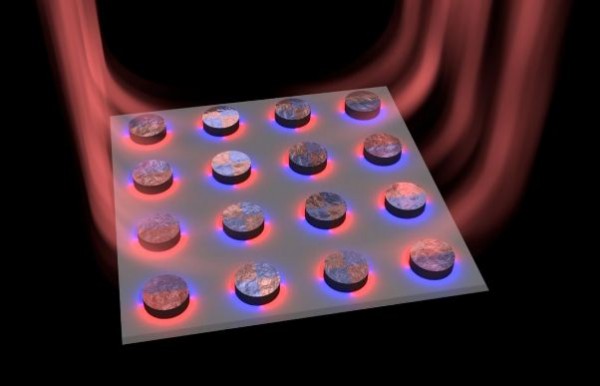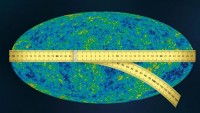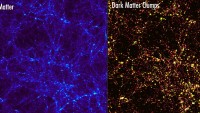Finnish Researchers Use Nanoparticles to Develop Minuscule Nanolaser
| Arthur Dominic Villasanta | | Jan 04, 2017 06:05 AM EST |
(Photo : Antti Paraoanu) An array of nanoparticles combined with dye molecules acting as a tiny laser. Lasing occurs in a dark mode and the laser light leaks out from the edges of array.
Researchers at Aalto University in Finland are the first to develop a plasmonic nanolaser that operates at visible light frequencies and uses what are called "dark lattice modes."
Like Us on Facebook
The achievement open new prospects for on-chip coherent light sources such as lasers that are extremely small and ultrafast.
The laser works at length scales 1,000 times smaller than the thickness of a human hair. The lifetimes of light captured in such small dimensions are so short the light wave has time to wiggle up and down only a few tens or hundreds of times.
The laser is based on silver nanoparticles arranged in a periodic array. In contrast to conventional lasers where the feedback of the lasing signal is provided by ordinary mirrors, this nanolaser utilizes radiative coupling between silver nanoparticles.
These 100 nanometer-sized particles act as tiny antennas. To produce high intensity laser light, the interparticle distance was matched with the lasing wavelength so all particles of the array radiate in unison.
Organic fluorescent molecules were used to provide the input energy (the gain) that is needed for lasing.
A major challenge in achieving lasing this way was that light might not exist long enough in such small dimensions to be helpful. Researchers found a smart way around this potential problem: they produced lasing in dark modes.
"A dark mode can be intuitively understood by considering regular antennas," said academy Professor Päivi Törmä.
"A single antenna, when driven by a current, radiates strongly, whereas two antennas -- if driven by opposite currents and positioned very close to each other -- radiate very little. A dark mode in a nanoparticle array induces similar opposite-phase currents in each nanoparticle, but now with visible light frequencies."
Dark modes are attractive for applications where low power consumption is needed, said staff scientist Tommi Hakala. He said dark mode lasing would be quite useless because the light is essentially trapped at the nanoparticle array and cannot leave.
By utilizing the small size of the array, however, the team found an escape route for the light, said Ph.D. student Heikki Rekola. Towards the edges of the array, the nanoparticles start to behave more and more like regular antennas that radiate to the outer world.
The research team used the nanofabrication facilities and cleanrooms of the national OtaNano research infrastructure. The results were published in the journal Nature Communications.
Tagsplasmonic nanolaser, Aalto University, laser, silver nanoparticles, Dark modes
©2015 Chinatopix All rights reserved. Do not reproduce without permission
EDITOR'S PICKS
-

Did the Trump administration just announce plans for a trade war with ‘hostile’ China and Russia?
-

US Senate passes Taiwan travel bill slammed by China
-

As Yan Sihong’s family grieves, here are other Chinese students who went missing abroad. Some have never been found
-

Beijing blasts Western critics who ‘smear China’ with the term sharp power
-

China Envoy Seeks to Defuse Tensions With U.S. as a Trade War Brews
-

Singapore's Deputy PM Provides Bitcoin Vote of Confidence Amid China's Blanket Bans
-

China warns investors over risks in overseas virtual currency trading
-

Chinese government most trustworthy: survey
-

Kashima Antlers On Course For Back-To-Back Titles
MOST POPULAR
LATEST NEWS
Zhou Yongkang: China's Former Security Chief Sentenced to Life in Prison

China's former Chief of the Ministry of Public Security, Zhou Yongkang, has been given a life sentence after he was found guilty of abusing his office, bribery and deliberately ... Full Article
TRENDING STORY

China Pork Prices Expected to Stabilize As The Supplies Recover

Elephone P9000 Smartphone is now on Sale on Amazon India

There's a Big Chance Cliffhangers Won't Still Be Resolved When Grey's Anatomy Season 13 Returns

Supreme Court Ruled on Samsung vs Apple Dispute for Patent Infringement

Microsoft Surface Pro 5 Rumors and Release Date: What is the Latest?














